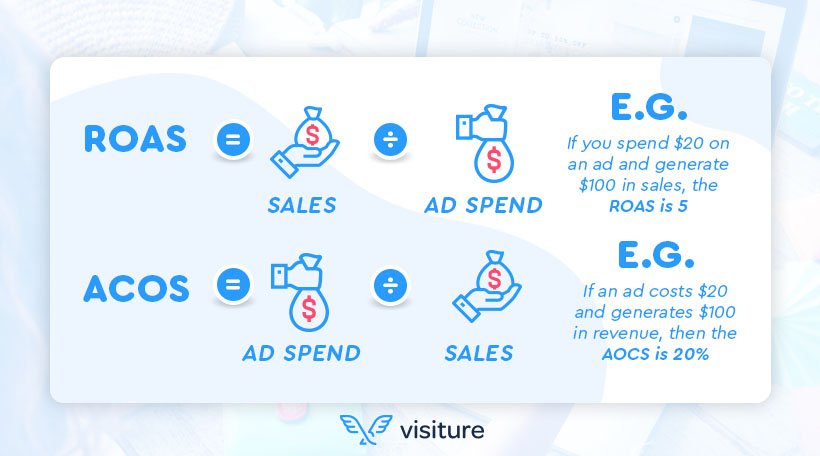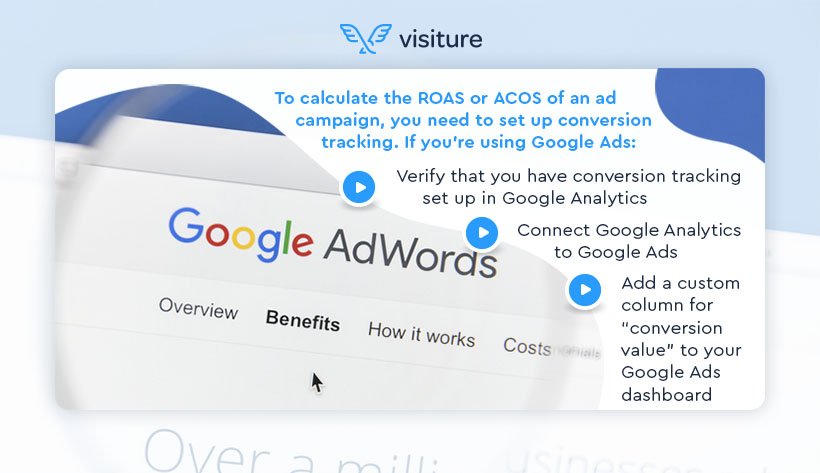If looking at all your PPC metrics makes your head spin, you’re not alone. But what if there’s a magic number that could show you whether your campaigns are doing what they’re supposed to – generating revenue and profits?
The good news is that it’s actually rather easy to get to the bottom of how effective your ads are by just focusing on two simple metrics – ROAS and ACOS.
In the world of online paid ads, ROAS stands for return on ad spend and ACOS stands for advertising cost of sale.
They help you determine if a PPC ad is worth the investment and give you insights to fine-tune your PPC strategy so your campaigns can become more profitable.
How To Calculate ROAS and ACOS
Here’s how to calculate ROAS and ACOS:
ROAS = Sales / Ad Spend
E.g., if you spend $20 on an ad and generate $100 in sales, the ROAS is 5.
ACOS = Ad Spend / Sales
E.g., if an ad costs you $20 and generates $100 in revenue, then the AOCS is 20%.
So, why should you get a handle on your PPC ads’ ROAS and ACOS?
ROAS and ACOS are essentially two sides of the same coin. They both show you the amount you spend on PPC ads in relation to the revenue that you generate from the ads.

Simply put, if you’re not making money from your ads, then you should make some changes or stop running them.
In order to be profitable, you need to know your break-even point for each ad, which is represented by either the minimum ROAS or maximum ACOS.
To determine this break-even amount, you’ll need just a few numbers:
- The revenue generated by the ads
- The cost of the goods sold by the ads
- Other fees involved in the sales (e.g., transaction fee, Amazon fees)
- Profit per sale
And then you can calculate your break-even ad spend:
Let’s say the revenue is $100, the cost of goods is $30, and the fees are $10. The profit will be $60 (Revenue – the cost of goods – other fees.)
If your ad spend is lower than $60, the campaign is making money. If your ad spend is $60, you’ll break even and if it’s higher than $60, you’ll actually be losing money on every item sold.
Since ROAS = Sales / Ad Spend, the minimum ROAS needs to be 1.67 ($100/$60) for the ad to be profitable.
And ACOS = Ad Spend / Sales, so maximum ACOS is 60% ($60/$100) or you’d be losing money on every sale.

Determining and Tracking ROAS and ACOS
ROAS and ACOS are typically campaign-specific and used to evaluate the effectiveness of an individual campaign, ad group, or keyword.
However, you also need to factor in other costs that go into running your business (e.g., operating cost, payroll) and setting up the campaigns (e.g., copywriting and graphic design) when you evaluate the profitability and ROI of your overall online advertising strategy.
Your target ROAS, therefore, should be higher than the minimum ROAS for your PPC campaign to be profitable.
To calculate the ROAS or ACOS of an ad campaign, you need to set up conversion tracking. It’s rather straightforward for most ecommerce sites since you can track the clicks from a PPC ad all the way to a purchase.
If you’re using Google Ads, simply verify that you have conversion tracking set up in Google Analytics, connect Google Analytics to Google Ads, and add a custom column for “conversion value” or “cost” to your Google Ads dashboard.

For non-ecommerce businesses, you’ll need to start with conversion tracking and then connect the advertising platform to your CRM system so you can attribute each ad to the leads it has generated.
Of course, tracking one product is quite straightforward. What happens if you’re selling multiple products?
To streamline ad management, group your ads according to targeted ROAS such that items with similar target ROAS are in the same ad group.
While there’s no hard and fast rule to determine what a “good” ROAS is, most businesses should aim for a 4:1 or higher ROAS in order to turn a profit.
In addition, you also need to take your marketing objectives into account. For example, if you’re launching a new brand and aim to generate awareness, then you may want to focus on generating buzz and driving traffic to your website. In that case, your target ROAS would likely be lower than 4.
How To Increase ROAS or Reduce ACOS
To improve the effectiveness of your PPC ad campaigns, you need to maximize the ROAS or minimize the ACOS.
Remember ROAS = Sales / Ad Spend and ACOS = Ad Spend / Sales?

The good news is that they share the same two variables!
If you’re keeping other factors that impact your ROI constant, then you can increase profitability by boosting the ROAS or lowering the ACOS of your campaigns.
This can be achieved by increasing sales (revenue) and/or reducing ad spend. Here’s how:
Increase Sales and Revenue
In order to drive more sales, you need to attract clicks that are most likely to convert:
- Improve your ad copy to drive more clicks. For example, mention special promotions, include social proof, use brand and product in the title, address objections, highlight unique selling points, and include a call-to-action.
- Adjust keywords and ad copy to reflect seasonal trends, such as holidays or mid-season sales, to keep your ads fresh and relevant.
- Match ad copy to the audience segment you’re targeting so it speaks to their specific challenges and needs. Two ads could have very different copy even when they’re promoting the same product if they’re designed to target different audiences.
- Identify “cost-effective keywords” by reviewing your search query reports to see what’s working, what’s not, and where your budget is being spent. When you know which keywords are generating the best results, you can allocate more ad dollars to them.
- Target long-tail keywords (e.g., brand and product name with other details), which can yield higher click-through and conversion rates when managed well. You can use tools such as Google search suggestions, Google Insights, and Google Trends to discover high-converting long-tail keywords.
- Include keywords that indicate high purchase intent, e.g., buy, discount, coupon, free shipping, brand name, product name, product attributes (e.g., size and color,) and product category.
- Add urgency using Google’s countdown feature to drive traffic that’s most likely to be ready to make a purchase.
- Message-match ad copy with the corresponding landing page to deliver a consistent user experience that’ll reduce friction and increase conversion.
- Experiment with creating dedicated landing pages for various ads. E.g., if an ad mentions a 50% discount, then the landing page should also highlight that promotion.
- Improve your site’s mobile experience to cater to the increasing number of consumers that are shopping with their mobile devices. If these visitors leave your site because of poor user experience, you’d be paying for clicks but losing the sales.
- Reduce friction along the purchasing path by implementing various conversion rate optimization (CRO) tactics to maximize average order value, minimize cart abandonment, and increase sales.
Lower Ad Spend
To reduce ad spend, be strategic about how you’re allocating your ad budget:
- Review your search term report and identify keywords that are getting clicks but not driving sales. Include these terms in the list of negative keywords so they won’t trigger your ads.
- Find out if there’s any avenue (e.g., display network) that’s generating clicks but not sales. Reduce the ad spend on those platforms so you’re not paying for traffic that doesn’t convert.
- Maintain your Google Ads quality score – a higher quality score translates into lower ad cost. You can improve your account’s quality score by making sure the ad copy and landing pages are relevant to the keywords you’re targeting.
- Optimize your bidding strategy, e.g., only show your ads during times when your target audience is most likely to be shopping. You can experiment with Google’s Smart Bidding feature, which takes into account various auction-time signals such as device, location, time of day, remarketing list, language, and operating system to optimize every single bid.
Conclusion
ROAS and ACOS are important metrics that indicate the effectiveness of your PPC ads by tracking revenue and profits so you can understand how well your marketing strategy is performing.
Leveraging the right analytics, you can drill down and measure the results of each campaign, ad group, or individual ad and make accurate data-driven decisions.
While the formulas for calculating ROAS and ACOS are quite straightfoward, there are many moving parts when it comes to dialing in your PPC strategy.
An ecommerce PPC management service can help you optimize every aspect of your PPC campaigns. For example, our clients earn an average of $4.80 for every $1 spent on PPC while one client’s average ROAS grew by 120% within a year.
Learn more about our PPC management service tailored for ecommerce businesses.







Responses